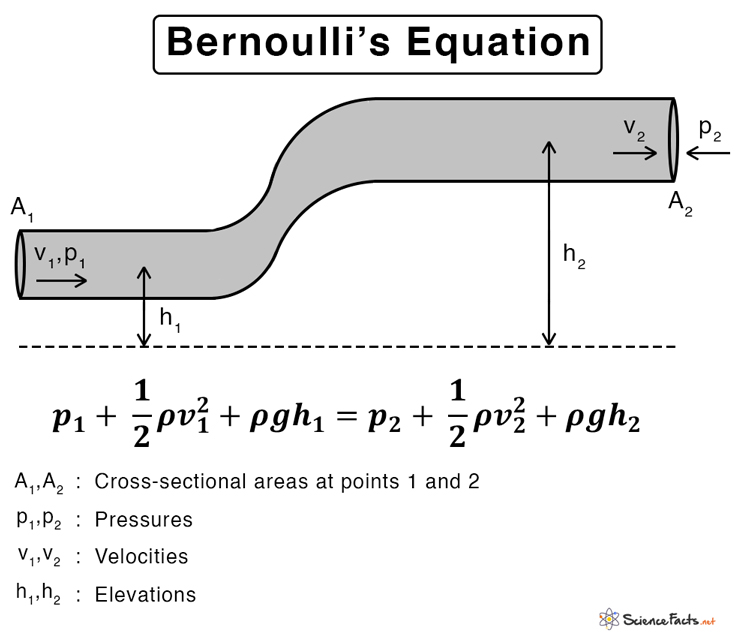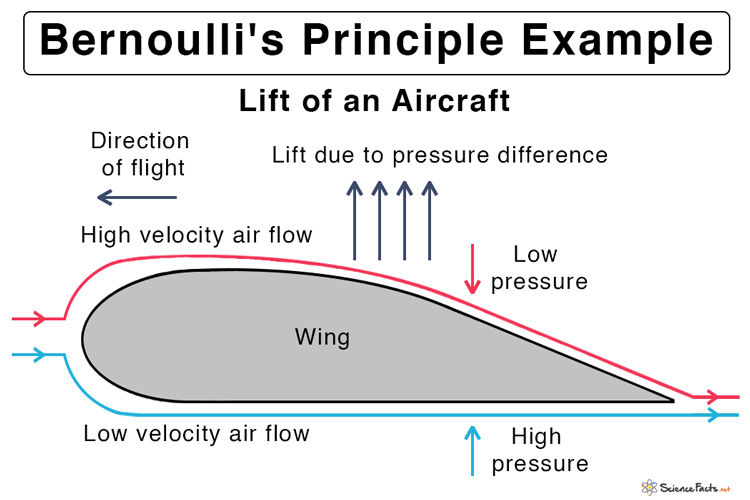What is Bernoulli’s Equation
Derivation of Bernoulli’s Equation
Applications of Bernoulli’s Principle and Equation
Limitation of Bernoulli’s Equation
Example Problems and Solutions
The equation is named after Swiss mathematician and physicist Daniel Bernoulli, who published it in 1738. Later, in 1752, another Swiss mathematician and physicist, Leonhard Euler, derived the equation. General Formula of Bernoulli’s Equation The equation is given as, p + ½ ρv2 + ρgh = constant Where, p: static pressure ρ: density of the fluid v: velocity of the fluid g: acceleration due to gravity h: height of the fluid from a reference The first term is the energy due to fluid pressure. The second term is the kinetic energy of the fluid motion, and the third term is the gravitation potential of the elevation. The sum of all three terms gives the mechanical energy of the fluid. Unit: Each term in the above equation has the unit of pressure, i.e., Pascal or Pa. (1 Pa = 1 N m-2) Consider two points 1 and 2 inside the tube through which the liquid flows. Putting the subscripts, the Bernoulli’s equation can be written as, p1 + ½ ρv12 + ρgh1 = p2 + ½ ρv22 + ρgh2
Bernoulli’s Equation Head Loss
The mechanical energy of a real fluid depends on the frictional work done to move the fluid. However, friction is excluded from Bernoulli’s equation. In many practical situations, problems related to real fluids can be analyzed with the help of a modified form of the equation. This new form enables to determine energy loss. The following equation is obtained by dividing Bernoulli’s equation by the fluid density and the acceleration due to gravity. p/ρg + ½ v2/g + h = constant In this equation, the units for all the different forms of energy are measured in distance units. Therefore, these terms are sometimes referred to as heads, such as pressure head, velocity head, and elevation head. The sum of all three heads of the fluid is called the total head. At two points 1 and 2, the equation is given by, p1/ρg + ½ v12/g + h1 = p2/ρg + ½ v22/g + h2 = hL The term hL is called the head loss and accounts for all major (friction) and minor (valves and elbows) losses between points 1 and 2. For an inviscid flow, hL = 0. The loss equation is important in studying hydropower. The head losses can be used to calculate the hydraulic head difference across a hydroelectric dam. Assumptions
The flow must be steady and streamline.The fluid is incompressible – the density should remain constant at all points during the flow.There are no viscous forces in the fluid, and friction is negligible.
Consider a pipe whose diameter and elevation change as a fluid passes through it. Consider a small mass of the fluid with density ρ that flows from point 1 to 2. The work done by a force F on the fluid to displace it by an infinitesimal distance dx is given by, W = Fdx Therefore, at points 1 and 2, the work done are, dW1 = F1dx1 dW2 = F2dx2 Total work done when the fluid moves 1 to 2 is, dW = dW1 – dW2 or, dW = F1dx1 – F2dx2 Force is the product of pressure and area (F = pA), and the volume is the product of length and cross-sectional area (V = Ax). Therefore, dW = p1A1dx1 – p2A2dx2 = p1dV – p2dV = (p1 – p2)dV Now, when the fluid moves from 1 to 2, there is a change of kinetic energy. dK = ½ m2v2 – ½ m1v1 = ½ ρdVv2 – ½ ρdVv1 = ½ ρdV(v1 – v2) Similarly, the change in potential energy is given by, dU = mgh2 – mgh1 = ρdVg(h2 – h1) The work done in moving the fluid is the sum of the change in kinetic and potential energies. dW = dK + dU or, (p1 – p2)dV = ½ ρdV(v22 – v12) + ρdVg(h2 – h1) or, p1 – p2 = ½ ρ(v22 – v12) + ρg(h2 – h1) or, p1 + ½ ρv12 + ρgh1 = p2 + ½ ρv22 + ρgh2 or, p + ½ ρv2 + ρgh = constant A practical application is the venturi tube or venturi flowmeter, an instrument for measuring the flow rate of fluids in pipes with accuracy. The tube is made with a constricted inner surface. The diameter of the outlet is the same as that of the inlet. The reduced cross-sectional area in the flow path generates a pressure and velocity difference. Bernoulli’s equation is also applied to wind turbines. It is helpful to investigate the airflow on either side of the turbines since it relates air velocity to the pressure difference across the turbine. This ability to study airflow allows determining how the turbines will operate and how much power can be generated. In aviation, Bernoulli’s equation can also be used to calculate the lift force on an airfoil during flight. Airplane wings have a larger top surface compared to the bottom surface. As the air moves across the relatively larger top surface, it must move faster than the air traveling a shorter distance under the bottom surface. Therefore, there is a lower pressure above the wing and higher pressure underneath it. This pressure difference provides lift for the aircraft, which is one of the forces of flight. Like airplane wings, Bernoulli’s principle can explain sailing. The spraying of perfume is an example of Bernoulli’s principle. Squeezing the bulb over the fluid generates a low-pressure area due to the higher speed of the air, which then draws the fluid up. Soln. Given, p1 = 300,000 Pa = 300,000 Nm-2 = 300,000 = 300,000 kg.m.s-2.m-2 = 300,000 kg.m-1.s-2 p2 = 101,300 Pa = 101,300 kg.m-1.s-2 h1 =h2 v1 = 2 m/s The Bernoulli’s equation is given by, p1 + ½ ρv12 + ρgh1 = p2 + ½ ρv22 + ρgh2 or, p1 + ½ ρv12 = p2 + ½ ρv22 or, p1 + ½ ρv12 = p2 + ½ ρv22 or, p1 – p2 = ½ ρ(v22 – v12) or, v22 – v12 = (2/ρ)(p1 – p2) or, v22 = v12 + (2/ρ)(p1 – p2) or, v2 = sqrt (v12 + (2/ρ)(p1 – p2)) or, v2 = sqrt ((1.5 m/s)2 + (2 / 1000 kg/m3)(250,000 kg.m-1.s-2 – 101,300 kg.m-1.s-2) = 17.3 m/s P.2. Water with a density of 1000 kg/m³ flows through a horizontal pipe. The pipe cross-section tapers from 60 cm² to 30 cm² at a reducer. The static pressure before the reducer is 5 bar and the flow velocity is 4 m/s. The flow is incompressible and frictionless. What static pressure is measured after the reducer? Soln. Given, v1 = 4 ms-1 A1 = 60 cm2 = 6 x 10-3 m A2 = 30 cm2 = 3 x 10-3 m p1 = 5 bar = 500,000 Pa = 500,000 kg.m-1.s-2 h1 = h2 ρ = 1000 kg.m-3 From equation of continuity, A1 v1 = A2 v2 or, v2 = A1 v1 / A2 or, v2 = (6 x 10-3 m x 4 ms-1)/ 3 x 10-3 m = 8 m/s From Bernoulli’s equation, p1 + ½ ρv12 + ρgh1 = p2 + ½ ρv22 + ρgh2 Since, h1 = h2 p1 + ½ ρv12 = p2 + ½ ρv22 or, p2 = p1 + ½ ρ(v12 – v22) or, p2 = 500,000 kg.m-1.s-2 + ½ x 1000 kg.m-3 (42 – 82) m2.s-2 = 476,000 kg.m-1.s-2 = 4.76 bar

